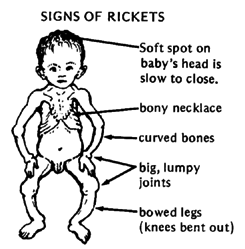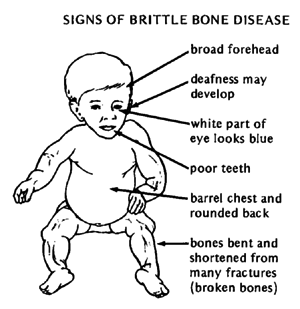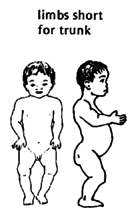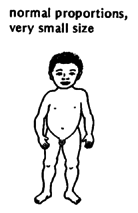CHAPTER 13
Children Who Stay Small
or Have Weak Bones
In this chapter we look at children whose bones are weak and deformed, and at children who do not grow as tall as other children. We includerickets, brittle bone disease, and children who stay very short (dwarfism). In all of these conditions, the legs may become bowed, and the shape or proportions of the bones are often not normal.
RICKETS
Rickets is weakness and deformity of the bones that occurs from lack of vitamin D. Vitamin D occurs in whole milk, butter, egg yolks, animal fats, and liver, especially fish liver oil. The body also makes its own vitamin D when sunlight shines on the skin. Children who do not eat enough foods with vitamin D, and who do not get enough sunlight, gradually develop signs of rickets.

Rickets is fairly common in some countries, especially in cool mountain areas of Asia and Latin America where babies are kept inside and wrapped up. Rickets is also increasing in crowded cities where children are seldom taken into the sunlight.
Treatment for rickets is to give fish liver oil, and to spend time in the sunlight. The best and cheapest form of prevention is to be sure sunlight reaches the child's skin. Foods that contain vitamin D also help.
BRITTLE BONE DISEASE
The child is born with bent or twisted limbs, or with broken bones. (Or he may seem normal at birth, and the bones begin to break later.) He may start to walk at near the normal age, but increasing deformities due to breaks may soon make walking impossible. Because of the many broken and bent bones, these children stay very short. Parents sometimes do not realize when their child breaks a bone.

Brittle bone disease is not common. Sometimes it is inherited, and someone else in the family will have the same problem.
There is no medical treatment. However, sometimes surgery can be done to straighten and strengthen the leg bones by putting a metal rod down the middle of them. This may help the child walk for longer, but he may eventually need a wheelchair to move about. Back problems increase with age; a body brace may help (see Page 164).
Children with brittle bone disease are often intelligent and do well in school. Increasing deafness may become a problem. Help them to develop their minds and learn skills that do not require physical strength. The child must learn how to protect his body from breaks. It helps to sleep on a firm bed.
CHILDREN WHO STAY SHORT (Dwarfism)
Parents often worry when a child does not grow as quickly as other children. Shortness has many causes. Here we discuss only a few.
| Normal slow growth. Some children normally grow more slowly and mature sexually later than others. If the child is normal and healthy in other ways, do not worry. He will probably grow quickly when he begins to grow up sexually, even if this happens as late as 15, 16, or 17 years old. | |
| Normal short size. When one or both parents are shorter than average, they may have children who are also short. Shortness 'runs in the family' and this is normal. Make sure the child is healthy and eats well. | |
| Poor nutrition. Some children do not grow normally because they do not get enough to eat, or do not eat the food their bodies need. They may seem normal except that they are thin, small, have big bellies, and get sick often. Or they may lack energy, seem very unhappy, or develop swollen feet, hands, and faces. These children need more and better food (see Page 321). They may also need more stimulation, play, love, and attention in order to grow and develop more quickly (see Chapter 35). | |
| Long-term illness or medication. Severe long illness often slows down a child's growth. Also, certain medicines such as cortisone or steroids for arthritis, if given for a long time, can slow down growth and weaken bones. | |
| Dwarfism. Some children are born with a condition in which the body does not grow normally. There are many different patterns and causes In 1 of 5 children it is inherited, and certain relatives will also be very short. |
 |
THREE TYPES OF DWARFISM
|
||
In the most common type of dwarfism, the arms and legs are short for the body. The head is big, the forehead bulges, and the bridge of the nose is flat. The child often has a swayback, pot belly, and bowlegs. Hip problems, club feet, or eye problems and hearing loss may occur.
TREATMENT
There is no medical treatment for most children who are short, including those with dwarfism. In many countries, doctors prescribe 'growth' hormones to short children to make them grow faster. These may cause some growth at first, but they soon make the bones mature and stop growing, so that the child stays smaller than he would have without treatment. Do not give hormones to speed growth.
Children who are very short for their age sometimes are made fun of by other children, or get treated as though they are younger than they really are. Life can be difficult for them and they may feel unhappy or unsure of themselves. It is important that everyone treat them just like other children their age. CHI LD-to-child activities can help other children become more understanding (see Chapter 47).





